Are you a Quiet Speculation member?
If not, now is a perfect time to join up! Our powerful tools, breaking-news analysis, and exclusive Discord channel will make sure you stay up to date and ahead of the curve.
Welcome back for another metagame update. I'm calling today's the "February update," even though it encompasses a week-and-a-half of March data as well. As we had extended last month's data, it made sense to do so this month too in order to avoid a three-week metagame with scant data. The astute reader will notice that March 12th is a Sunday, which seems a natural cutoff point as most Magic tournaments occur on weekends. In January we saw the beginning shockwaves from the Gitaxian Probe and Golgari Grave-Troll bannings—in some ways that month was a hard one to evaluate, since the data spanned the date the bans went into effect, but we could still see clear indications that we were facing a new Modern. In February these trends become even more marked, and take on some new directions as well.
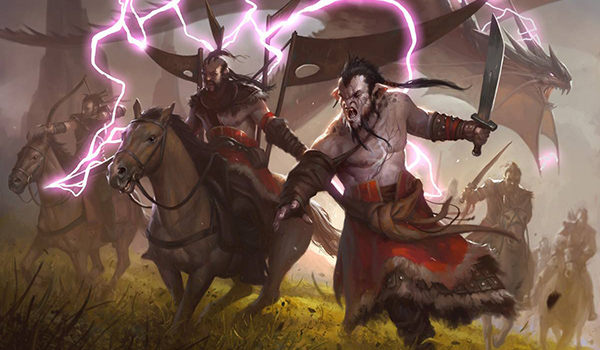
Overall, the large-scale image is of a format more diverse, more fair, more interactive—in short, a healthier one by most players' standards. Today we'll look at the February/early-March data taken as a unit, but I'll also be comparing pre- and post-banning pictures of the metagame at large. Over the last few months I've made some updates to the metagame spreadsheet which make manipulating the data easier—today I get to roll out a first test of how this flexibility can be used to augment our analysis.
Data Collection Methods
In our data set for this month there were no major events on MTGO, which means the online data consists entirely of League finishes. At one per day, we have 35 events for a total of 345 decks. The paper data spans 782 individual decks over 117 tournaments.
Two new sources have been added to the paper events. The first are tournaments from Magic-League, a tournament series that's organized online where participants play out full matches on third-party software like Cockatrice. For the moment these tournaments are relatively rare and don't attract large numbers of players, but who knows—maybe it's the future of competitive Magic! You can read more about Magic-League here.
The other source I'm adding in (and this is a work in progress) hails from Brazil. Right now our data set heavily favors Europe and North America. While it's true most tournaments occur in those regions, there's no reason to limit ourselves if other data is available. LigaMagic has been running a tournament series in Brazil with qualifier tournaments and corresponding "seasons," and they've recently begun to post decklists. This series spans the entire country, so we're looking at tons of extra data points. In this month's date range, for example, there were 22 qualifier tournaments with reported decklists. For most of these tournaments, unfortunately, only the winning decklist is reported, but this still represents a much better view of the Latin-American Modern scene than we've had up until now. I'm looking to expand these efforts too—so if you live in the region and know of any regular tournament series that aren't being incorporated in our data, let us know in the comments where any results may be found.
Major paper Top 8s for this period were numerous, with a Star City Games Classic and Open each in Dallas and Indianapolis, the SCG Baltimore Classic, and Grands Prix in Brisbane and Vancouver. Note that the Open in Baltimore was a split-format team event, so top-finishing Modern decks were reported as regular paper events, down to 16th place. TCGPlayer States also appears in the paper data this month.
For the two Grand Prix, Wizards didn't publish any Day 2 metagame data this time (past coverage has included a breakdown of archetypes appearing in the Top 100). To simulate this as best as possible, I compiled these data from the posted Top 32 finishes, together with the trial-winning decks from each GP. SCG, for their part, published the Day 2 metagame breakdown as normal, so that remains the same.
Tier 1
Tier 1 decks are the ones you should expect to face at every Modern tournament. Make sure you show up to your local events and Grand Prix alike with a well thought-out plan to beat these decks—you’re going to face them often, and each one is resilient enough to fight through a lackluster counterplan. Of course another avenue is to pick one of these up yourself, which I generally suggest for anyone not well-versed in a lower-tier deck. Whether you know one of these archetypes inside-out and can tune a killer sideboard for the field, or you want to pick up something new and wing it, these decks certainly have the chops to get the job done.
Tier 1: 2/6/17 - 3/12/17
| Deck | Overall Metagame % | Paper % | MTGO % |
|---|---|---|---|
| Death's Shadow Jund | 7.7% | 5.6% | 9.6% |
| Burn | 6.7% | 6.3% | 5.2% |
| Bant Eldrazi | 6.6% | 6.3% | 3.2% |
| Affinity | 5.2% | 6.4% | 5.5% |
| Eldrazi Tron | 5.2% | 3.6% | 9.6% |
| Abzan | 4.9% | 4.1% | 6.4% |
| RG Valakut | 4.7% | 4.1% | 5.2% |
| Gx Tron | 4.5% | 5.9% | 2.9% |
Many pros have made no bones about their opinion that Death's Shadow is the strongest deck right now, and that's clearly borne out in the February metagame. I have my suspicions about its ability to stay on top for months on end or warp the format around it, but in the early post-banning meta Death's Shadow is indisputably on top. By now you're almost certainly familiar with the new Probeless version, which amalgamates elements of the Death's Shadow Zoo deck with traditional Jund Midrange. 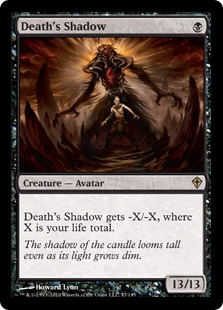 As a result this deck has shifted to a different spot on the metagame wheel, downplaying its gotcha! and combo dimensions in favor of a grindier, more late-game-focused approach. If you haven't had the joy of playing with or against this strategy yet, consider that mandatory homework for any upcoming major tournament. This deck is resilient and more than capable of winning through disruption, but it can also generate explosive kills from out of nowhere, akin to Splinter Twin and Birthing Pod decks of yore.
As a result this deck has shifted to a different spot on the metagame wheel, downplaying its gotcha! and combo dimensions in favor of a grindier, more late-game-focused approach. If you haven't had the joy of playing with or against this strategy yet, consider that mandatory homework for any upcoming major tournament. This deck is resilient and more than capable of winning through disruption, but it can also generate explosive kills from out of nowhere, akin to Splinter Twin and Birthing Pod decks of yore.
The rest of Tier 1 shouldn't come as much of a surprise, with the lone exception of Eldrazi Tron. That deck has been bolstered by the printing of Walking Ballista, which provides another mana sink for excess Urzatron pieces and fits like a glove into a deck trying to present a steady stream of threats with disruptive capabilities. Bant Eldrazi has long been a Tier 1 mainstay, ever since its demotion from Tier 0 status effected by the Eye of Ugin banning. Eldrazi Tron shares many cards in common, of course, so it's not crazy to see how it might be similarly positioned.
As I said, everything else appearing in Tier 1 is pretty standard, but there are some, shall we say, rather notable omissions: Infect, Dredge, and Jund. The first two are obviously a result of Wizards' targeted bannings, which aimed to reduce non-interactive strategies and turn-three kills (more on that below). What's more interesting is Jund's fall from grace, which is unprecedented enough to merit closer consideration.
I see several ways to understand the longtime titan's foray into Tier 2 territory. It's tempting to conclude that the demotion of Infect or the rise of Tron have removed some of the incentive to sleeve up Jund. But in reality there are other decks occupying the same metagame space—thus both Death's Shadow and Abzan have likely cannibalized some of Jund Midrange's metagame share. 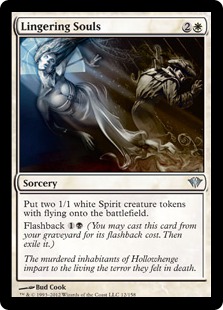 BGx decks have always competed among each other for superior standing, and the printing of Fatal Push has given the proponents of Lingering Souls and Siege Rhino yet another mechanism to compensate for a lack of access to Lightning Bolt. This may be accentuated by additional pressure in the form of Grixis and Esper control strategies—all in all, Fatal Push means Jund is no longer unique in its ability to reliably and efficiently kill creatures as early as turn one with no downside.
BGx decks have always competed among each other for superior standing, and the printing of Fatal Push has given the proponents of Lingering Souls and Siege Rhino yet another mechanism to compensate for a lack of access to Lightning Bolt. This may be accentuated by additional pressure in the form of Grixis and Esper control strategies—all in all, Fatal Push means Jund is no longer unique in its ability to reliably and efficiently kill creatures as early as turn one with no downside.
As for the Death's Shadow decks, in many cases they can do a great Jund impression, but they have the upside of sometimes just outright killing opponents from nowhere. Free wins shore up matchups like Gx Tron and RG Valakut, which Jund Midrange has struggled with immensely in the past. All of these factors beg the question: why play the midrange grindy strategy that can't boast free wins like Death's Shadow, nor trump the pseudo-mirror like Abzan? My guess is that many traditional BGx adherents have switched to one of these two decks.
Unpacking the Effect of the Bannings
Last month we began to delineate the contours of the post-banning meta, but in a period straddling the bans (and the release of Aether Revolt), the data were hard to make sense of. With the February data we have a much clearer picture and can draw more firm conclusions about the effect of the bans on Modern as a whole.
In order to examine this, I decided to put together a snapshot of the format both before and after the bannings. Some choice updates to the metagame spreadsheet have made this possible—before, fiddling around with dates, archetype names, and other input criteria was cumbersome, to say the least. 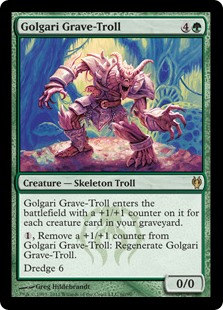 I hope to expand this customizability in the future, but for now let's look at how the Gitaxian Probe and Golgari Grave-Troll bans have changed Modern.
I hope to expand this customizability in the future, but for now let's look at how the Gitaxian Probe and Golgari Grave-Troll bans have changed Modern.
The bans went into effect in the middle of January. I've extended the time frame back to December 1 for the pre-banning meta, and out to February 28 for the post-banning meta. Note that the numbers we've looked at thus far are for the period extending to March 12, so there won't be direct correspondence between the metagame shares reported. Also note that the numbers here represent a different cutoff date for MTGO and paper events, as the bans went into effect on different days. Thus the pre-banning meta is comprised of all decks in our data from the period Dec 1 - Jan 19, except in the case of MTGO decks, which stop at Jan 10th. The post-banning meta comprises all decks from Jan 20 - Feb 28, together with the MTGO decks from the 11th to the 19th.
If we calculate each of these data sets as separate metagames, we end up with the following metagame shares. The decks appearing below comprise every archetype that appears in Tier 1 in either of the two periods. Under the column marked "Tier Shift," you can see which archetypes moved up or down in standing across the banning divide.
Pre- and Post-Ban Metagame Share
| Archetype | % Change | Post-Banning Meta % (Bannings - 2/28) | Pre-Banning Meta % (12/1 - Bannings) | Tier Shift |
|---|---|---|---|---|
| Death's Shadow Zoo/Jund* | +2.6% | 6.3% | 3.7% | ↑ Up |
| Bant Eldrazi | +2.9% | 6.1% | 3.2% | ↑ Up |
| Burn | -0.4% | 5.9% | 6.3% | - |
| Abzan | +1.1% | 5.9% | 4.8% | - |
| RG Valakut | +1.2% | 5.6% | 4.4% | - |
| Affinity | +0.7% | 5.2% | 4.5% | - |
| Gx Tron | +0.2% | 5.0% | 4.8% | - |
| Jund | -3.7% | 4.5% | 8.2% | - |
| Eldrazi Tron | +2.9% | 4.5% | 1.6% | ↑ Up |
| Infect | -5.1% | 2.4% | 7.5% | ↓ Down |
| Dredge | -4.5% | 2.4% | 6.7% | ↓ Down |
[su_spoiler title="Naming convention for Death's Shadow strategies" style="fancy"]Prior to the Gitaxian Probe banning, we reported Death's Shadow decks under the name "Death's Shadow Zoo." As the post-banning deck took form and underwent several compositional shifts, we began to use "Death's Shadow Jund" to designate the new archetype. In order to effect a comparison this month, both decks are being treated as one—so some of the January share comes from the pre-banning Zoo-type deck featuring Become Immense. Note that both before and after the bans, we've kept Grixis Death's Shadow as a separate archetype.[/su_spoiler]
The first thing to notice is holy crap did Infect and Dredge get nerfed. Between the two they've shed 9.6% share, almost a full tenth of the entire metagame. To look at it another way, both archetypes lost about two-thirds of their pre-banning representation, dropping from uncontested Tier 1 to solidly Tier 2. If the goal was to downgrade the prior scourges of the format, Wizards' choice in bans was clearly well suited to the task. 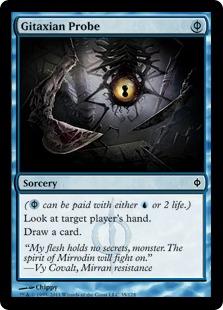 I've speculated elsewhere about these decks' positioning in the post-ban environment—regardless of the reason, I predict that Infect and Dredge are likely to stay Tier 2 for the foreseeable future. If we consider that some people may be holding onto these decks out of stubbornness or due to card availability, it seems safe to say they're not good choices at the moment.
I've speculated elsewhere about these decks' positioning in the post-ban environment—regardless of the reason, I predict that Infect and Dredge are likely to stay Tier 2 for the foreseeable future. If we consider that some people may be holding onto these decks out of stubbornness or due to card availability, it seems safe to say they're not good choices at the moment.
Second, we see the drop in Jund's position pretty clearly as well. Its 3.7% loss after the bannings happens to perfectly match the combined rise in Abzan and Death's Shadow. The fact that the numbers correspond exactly is a coincidence, to be sure, but it lends further credence to the claim I made above about BGx pilots shifting gears. Note that in the period from the bannings to February 28, Jund still qualifies as Tier 1—it's downward slide wasn't completed yet (and may not be still).
Third, there's the question of the spaghetti monsters. Eldrazi strategies combined gained 5.8% metagame share across the banning divide (ignoring the lower-tier stuff like Colorless Eldrazi Stompy or Eldrazi and Taxes). If we understand both Bant Eldrazi and Eldrazi Tron as similar decks that aim to execute a midrange fair strategy with disruptive creatures, it makes sense to see them gain in an environment freed from the clutches of non-interactive nonsense. It's not just that Infect and Dredge are down. Other lower-tier stuff is down too (looking at you, UR Prowess). 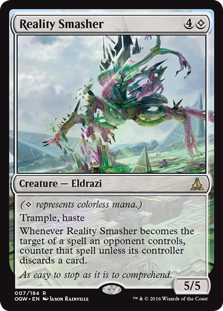 And while, nominally, Death's Shadow is still kicking it at the top tables, the new deck isn't as explosive or punishing. All of this gives durdlier decks an opening. Finally, it should be noted that a reasonable answer to the rise in presence of Fatal Push is to just cast five- and six-drops. Outside of Primeval Titan and Wurmcoil Engine, there are precious few playable creatures at this spot on the curve—and due to their unique mechanics, Eldrazi can be accelerated out more easily than most.
And while, nominally, Death's Shadow is still kicking it at the top tables, the new deck isn't as explosive or punishing. All of this gives durdlier decks an opening. Finally, it should be noted that a reasonable answer to the rise in presence of Fatal Push is to just cast five- and six-drops. Outside of Primeval Titan and Wurmcoil Engine, there are precious few playable creatures at this spot on the curve—and due to their unique mechanics, Eldrazi can be accelerated out more easily than most.
The rest of the changes are less pronounced, with some typical-looking 0-1% shifts. While fair is on the upswing and hyper-fast aggro is down, this Modern is still eminently recognizable. Burn, Valakut, Affinity, Tron—the other usual suspects aren't going anywhere.
Changes: February to March
| Deck | % Change January to February | Overall Meta % 2/6 - 3/12 | Overall Meta % 1/1 - 2/5 |
|---|---|---|---|
| Death's Shadow Jund* | +4.8% | 7.7% | 2.9% |
| Burn | +1.3% | 6.7% | 5.4% |
| Bant Eldrazi | +1.8% | 6.6% | 4.8% |
| Affinity | -1.4% | 5.2% | 6.6% |
| Eldrazi Tron | +3.1% | 5.2% | 2.1% |
| Abzan | -0.1% | 4.9% | 5.0% |
| RG Valakut | -0.9% | 4.7% | 5.6% |
| Gx Tron | -0.9% | 4.5% | 5.4% |
Returning to the central period of focus, let's look at the changes to Tier 1 that took place between January and February/early March. Most of the changes in this chart follow naturally from the proceeding one. In the case of Jund and Death's Shadow, the respective trends have accelerated. By now Jund has fallen further and dropped to Tier 2 (at 3.1%), while Death's Shadow continues to grow. Eldrazi Tron shows about the same rate of growth as reported in the chart above, suggesting much of this happened in the later part of February. 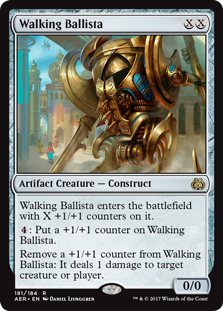 This gels with the idea that Walking Ballista is specifically responsible. The growth of Bant Eldrazi, on the other hand, has slowed a little.
This gels with the idea that Walking Ballista is specifically responsible. The growth of Bant Eldrazi, on the other hand, has slowed a little.
Of course, we're a full month and a half after the bannings, and the metagame is starting to react and shift into secondary (or tertiary) iterations. RG Valakut seemed to benefit from the bans initially, but has since lost most of its gains. Gx Tron is in a similar boat. Finally, for some reason Burn is gaining (+1.3%) while Affinity is suffering (-1.4%). This represents a reversal of last month's trend. The only reason I can think of for this would be Death's Shadow Jund making ample use of Ancient Grudge to keep the robots in check—let me know in the comments if there's something else I've missed.
Tier 2
Tier 2 decks are not as omnipresent as the Tier 1 crop, but they still show up in hearty numbers at the typical tournament. In many ways this tier is the lifeblood of Modern, whence its diversity and “play anything” reputation stems. If these decks aren’t dominating at the moment, they’re still capable of crushing a tournament on any given day—and many of them have been Tier 1 at some point in the past or will in the future. The better acquainted you are with any one of these archetypes, the better choice it represents, and if one of them is your specialty there’s a strong argument to stay the course and keep sleeving it up.
As for preparing to beat Tier 2 decks, you don’t need to dedicate specific sideboard space or do backflips to make your matchups favorable, but at minimum have a plan. You won’t face all of these decks in a tournament, but you’re all but certain to face at least some of them. Welcome to Modern!
Tier 2: 2/6/17 - 3/12/17
| Deck | Overall Metagame % | Paper % | MTGO % |
|---|---|---|---|
| Jund | 3.1% | 2.8% | 5.2% |
| Merfolk | 2.8% | 2.7% | 2.6% |
| Grixis Delver | 2.5% | 2.7% | 2.9% |
| Abzan Company/Evolution | 2.5% | 2.7% | 0.9% |
| Grixis Control | 2.4% | 3.3% | 1.7% |
| Infect | 2.2% | 2.4% | 0.3% |
| Ad Nauseam | 2.1% | 2.3% | 1.7% |
| Jeskai Control | 2.1% | 2.6% | 1.4% |
| Dredge | 1.9% | 1.3% | 2.3% |
| Bushwhacker Zoo | 1.8% | 1.3% | 2.0% |
| Elves | 1.7% | 1.9% | 1.2% |
| RW Prison | 1.6% | 1.4% | 0.9% |
| Gifts Storm | 1.5% | 1.5% | 3.8% |
| Eldrazi and Taxes | 1.4% | 0.9% | 2.0% |
| Lantern Control | 1.4% | 1.3% | 1.7% |
| Living End | 1.3% | 1.9% | 0.3% |
| Griselbrand | 1.2% | 1.3% | 1.2% |
Both the Tier 2 and Tier 3 rosters have ballooned this month, indicating a rise in diversity and further cementing the evidence of a healthier Modern. The only major drop in metagame share here this month (besides to the prior Tier 1 darlings Infect, Dredge, and Jund) was Merfolk, which fell 1.2%. Beyond that, we see the return of Living End, Storm, and Bushwhacker Zoo, and the supplanting of UW Midrange/Control by Jeskai versions. Let's look at the major changes in turn.
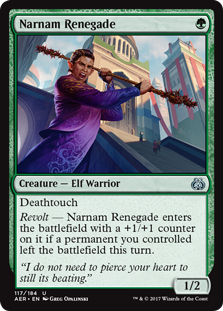 Bushwhacker Zoo makes a triumphant return on the back of revolt. Bushwhacker Zoo is back to Tier 2 after several months wavering between no ranking and Tier 3, and it's received a little bit of a face lift. Some outlets have called this deck "Revolt Zoo," for the prominent use it makes of the new mechanic out of Aether Revolt. Burning-Tree Emissary was always a central component of this deck's plan, and Hidden Herbalists just ensures it's that much more likely to spew its hand out in the early game. The archetype also gained access to the newest Kird Ape impersonator, Narnam Renegade. While it will be harder to turn on to full power than the Monkey, Renegade gets to attack into anything, Goyfs and Thought-Knot Seers included. It also offers a deck like Bushwhacker Zoo a rare defensive tool against the likes of Death's Shadow when it falls behind. Builds are still pretty non-standard (some have even included copies of Greenwheel Liberator), so it's anyone's guess where this archetype goes from here.
Bushwhacker Zoo makes a triumphant return on the back of revolt. Bushwhacker Zoo is back to Tier 2 after several months wavering between no ranking and Tier 3, and it's received a little bit of a face lift. Some outlets have called this deck "Revolt Zoo," for the prominent use it makes of the new mechanic out of Aether Revolt. Burning-Tree Emissary was always a central component of this deck's plan, and Hidden Herbalists just ensures it's that much more likely to spew its hand out in the early game. The archetype also gained access to the newest Kird Ape impersonator, Narnam Renegade. While it will be harder to turn on to full power than the Monkey, Renegade gets to attack into anything, Goyfs and Thought-Knot Seers included. It also offers a deck like Bushwhacker Zoo a rare defensive tool against the likes of Death's Shadow when it falls behind. Builds are still pretty non-standard (some have even included copies of Greenwheel Liberator), so it's anyone's guess where this archetype goes from here.
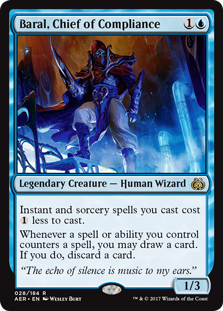 Gifts Storm arrives in full glory. Just when you thought the most broken mechanic of all time was dead, it's...well, not. When Gitaxian Probe was banned, Storm aficionados were understandably upset at the way their beloved deck was getting hit with splash damage as a result of Infect's and Death's Shadow's crimes. Wizards, of course, is hyper-vigilant about ensuring decks like Storm can't ascend to the higher tiers, and for good reason. All it took was the printing of an innocuous card like Baral, Chief of Compliance to bring the deck back on the radar. When your fundamental mechanic says, "cast a large number of spells for free," you've got a deadly combination of broken card advantage plus free mana. Nothing, mind you, suggests that this version of Storm is a problem—but it does sort of validate Wizards' cautious approach to the truly unfair strategies in Modern.
Gifts Storm arrives in full glory. Just when you thought the most broken mechanic of all time was dead, it's...well, not. When Gitaxian Probe was banned, Storm aficionados were understandably upset at the way their beloved deck was getting hit with splash damage as a result of Infect's and Death's Shadow's crimes. Wizards, of course, is hyper-vigilant about ensuring decks like Storm can't ascend to the higher tiers, and for good reason. All it took was the printing of an innocuous card like Baral, Chief of Compliance to bring the deck back on the radar. When your fundamental mechanic says, "cast a large number of spells for free," you've got a deadly combination of broken card advantage plus free mana. Nothing, mind you, suggests that this version of Storm is a problem—but it does sort of validate Wizards' cautious approach to the truly unfair strategies in Modern.
It also highlights the value of brewing—the players who imagined Baral's place in Pyromancer Ascension decks and predicted (correctly) that it would be mediocre were outperformed by the more creative types who thought to explore the use of Gifts Ungiven. As we've seen many times before, this innovation was spearheaded on MTGO. In January the deck's online share (1.2%) was more than twice that on paper (0.6%). February continues the trend, both in terms of overall archetype growth and in the disparate representation on MTGO.
 Jeskai Control supplants UW Control. The only archetype to drop entirely off of Tier 2 this month was UW Control/Midrange. I think it's unlikely a coincidence that Jeskai Control came back in the same month, claiming about the same amount of metagame share as UW last month (2.1% to 1.9%, respectively). I don't see a compelling reason why these would have switched suddenly, and I'm inclined to chalk it up to what's en vogue. Jeskai Control this month encompasses three different builds that found more or less equal representation: Jeskai Nahiri, Jeskai Saheeli, and more traditional spell-based Jeskai Control. A fourth type, Kiki-Jiki decks, appeared here and there. More people are certainly trying out the Saheeli Rai/Felidar Guardian combo in Modern these days, but that only accounts for one part of the deck's gains, and doesn't really explain why UW would be down.
Jeskai Control supplants UW Control. The only archetype to drop entirely off of Tier 2 this month was UW Control/Midrange. I think it's unlikely a coincidence that Jeskai Control came back in the same month, claiming about the same amount of metagame share as UW last month (2.1% to 1.9%, respectively). I don't see a compelling reason why these would have switched suddenly, and I'm inclined to chalk it up to what's en vogue. Jeskai Control this month encompasses three different builds that found more or less equal representation: Jeskai Nahiri, Jeskai Saheeli, and more traditional spell-based Jeskai Control. A fourth type, Kiki-Jiki decks, appeared here and there. More people are certainly trying out the Saheeli Rai/Felidar Guardian combo in Modern these days, but that only accounts for one part of the deck's gains, and doesn't really explain why UW would be down.
Tier 3
Tier 3 in Modern houses the decks with fringe potential, or those which are simply in a poor position in the current metagame. These decks range from relatively strong decks with scant adoption in the player base, to fragile decks that crumble to variance while mainstays like Burn or Jund draw consistently round after round. That said, Modern draws from an absurd well of card power, and each of these decks can give you a run for your money. You don’t need perfect knowledge of everything they’re doing, but the difference between familiarity and complete ignorance can definitely determine the outcome of a match.
Playing these decks isn’t advised, unless you know them inside-out or have some specific reason why you think they’re underrepresented. Of course, they are also worth a look as fun decks to battle if you’re less concerned about winning and want to delve into the deeper end of the Modern pool.
Tier 3: 2/6/17 - 3/12/17
| Deck | Overall Metagame % | Paper % | MTGO % |
|---|---|---|---|
| RG Ponza | 1.2% | 1.3% | 0.3% |
| Scapeshift | 1.2% | 0.9% | 0.3% |
| Esper Control | 1.0% | 1.2% | 0.6% |
| Bogles | 0.9% | 0.6% | 0.6% |
| Nykthos Green | 0.8% | 0.6% | 1.4% |
| Death and Taxes | 0.8% | 1.0% | 2.0% |
| Jeskai Midrange | 0.8% | 1.0% | 0.0% |
| 8Rack | 0.7% | 0.5% | 0.6% |
| Blue Moon | 0.7% | 0.8% | 0.3% |
| Knightfall | 0.7% | 0.5% | 1.4% |
| Amulet Titan | 0.7% | 0.3% | 1.2% |
| Cheeri0s | 0.6% | 0.8% | 0.6% |
| Skred Red | 0.6% | 0.9% | 0.0% |
| Taking Turns | 0.6% | 0.6% | 0.3% |
| UW Control/Midrange | 0.6% | 0.8% | 0.3% |
| Kiki Chord | 0.6% | 0.9% | 0.6% |
| Bant Spirits | 0.6% | 0.9% | 0.6% |
| Faeries | 0.5% | 0.9% | 0.3% |
| Naya Company | 0.5% | 0.9% | 0.0% |
| Grixis Death's Shadow | 0.4% | 0.3% | 0.9% |
| Mardu Control/Midrange | 0.3% | 0.4% | 0.3% |
If the Tier 2 standings indicate a diversification of viable strategies in Modern this month, the proliferation of Tier 3 decks represents a veritable explosion. We classified 16 decks as Tier 3 in January. That number has risen to 21 this month, and I could have extended them further down if I was inclined to. 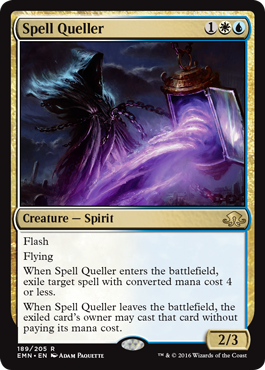 As always, the numbers near the bottom of the metagame standings are always based on a relatively small n, but the shakeups here are pretty extensive nonetheless.
As always, the numbers near the bottom of the metagame standings are always based on a relatively small n, but the shakeups here are pretty extensive nonetheless.
There are a lot of new arrivals: 8Rack, Bant Spirits, Cheeri0s, Naya Company, Nykthos Green, RG Ponza, and Taking Turns. None of these decks appear regularly in Tier 3, and several are here for their first tiered appearance. In the case of Cheeri0s, its newfound success can be attributed to a recent printing, but in every other case we're just seeing old strategies fare better than before. On the other hand, the only deck to disappear from Tier 3 this month was UR Prowess—one of the uninteractive decks that had been contributing to the strangling of lower-tier strategies before the banning.
The biggest individual story here appears to be RG Ponza, an odd deck to say the least. Wizards long ago pronounced the competitive death of designated "unfun" strategies like land destruction and prison, but Moderners know their format has become the last repository for these types of archetypes. 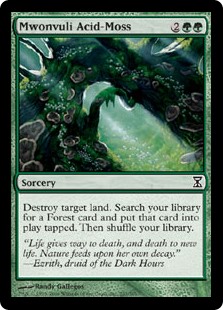 Ponza is an honest-to-god, full-on land destruction deck that complements Blood Moon with targeted spells like Mwonvuli Acid-Moss and actual Stone Rain to attack a player's mana base directly. This deck has benefited from the printing of Chandra, Torch of Defiance, which provides another sticky threat to ramp into and mitigate flood. But I'm not gonna lie—I don't see this deck putting up these numbers in the kind of environment dominated by Infect, Dredge, Death's Shadow Zoo, and the other explosive linear decks that characterized the pre-banning Modern.
Ponza is an honest-to-god, full-on land destruction deck that complements Blood Moon with targeted spells like Mwonvuli Acid-Moss and actual Stone Rain to attack a player's mana base directly. This deck has benefited from the printing of Chandra, Torch of Defiance, which provides another sticky threat to ramp into and mitigate flood. But I'm not gonna lie—I don't see this deck putting up these numbers in the kind of environment dominated by Infect, Dredge, Death's Shadow Zoo, and the other explosive linear decks that characterized the pre-banning Modern.
Another deck that has similarly benefited from the more interactive and fair environment is Nykthos Green, which here includes Tooth and Nail variants. These decks durdle a little too hard to face off against a slew of aggro-combo decks and turn-four kills, but they can give value-based decks like Abzan or Eldrazi a run for their money. If the game goes long enough, rest assured that a Genesis Wave, Tooth and Nail, or good old Primeval Titan will serve as a reliable enough trump to the more midrangey threats out of BGx and Eldrazi. These decks might be taking a chunk out of Amulet Titan's share, which itself has fallen to Tier 3 after a brief sojourn up the ranks last month.
Conclusion
It's refreshing to see such diversity in the lower two tiers of the Modern metagame, and there's a certain poetry to watching Dredge and Infect take their medicine. Modern is in a great place right now, and if we appear to have a best deck in Death's Shadow Jund, it's great to hear pros and grinders proclaim it a skill-intensive, interesting deck to play both with and against. We haven't seen the end of the metagame shifts either, and I'm confident people will figure out how to combat the Death's Shadow decks.
So for now it appears we've returned to a golden age for the Modern format. Let's hope I don't have to put my foot in my mouth on this one any time soon—god knows Standard isn't offering the same kind of interest and variety. Now please excuse me while I spend the next four weeks drafting Modern Masters 2017 like a degenerate lunatic…




Hey Jason, thanks for the update! I always love reading these. In regards to the higher percentage of Burn, as a Burn player myself, I think I may be able to provide some insight. Firstly, alot of modern players have started claiming the deck is dead, especially on Reddit. Lots of people believe fast lands from Kaladesh kill the deck, which is wholly untrue. As the Tier One elaboration paragraph says, “if you don’t prepare or have a weak plan, these decks will break through”. In addition, with the rise of Death’s Shadow Jund, I personally believe we have gained another good matchup. Most of the people on the deck are Jund players, not people who mastered the Pre-Ban version of the deck. As such, it is quite an easy matchup for me versus people who aren’t experienced. As a Burn player, all I have to do it hold instant speed spells and wait till you commit too hard. Lots of Jund players seem to do this, I guess infatuated with their newfound killing machine. I personally think that because DSJ is rising, lots of solid Burn players are taking advantage. I believe these are valid reasons for Burn rising, personally. Any thoughts on any of that? Burn is also a self-solving deck, akin to Affinity, so I doubt it’ll get the same representation this month or so.
Ahhhh yes, faeries cracked into tier 3
When high profile pros like Ari Lax talk all kinds of smack about Burn, Burn players want to shut them up 🙂 Yes DSJ has a lot of discard, but they can’t always make us discard our Deflecting Palms. I was already running 3 Palm before DSJ became a thing and I run a full complement now. Bursting damage out is very effective, one of the biggest issues for Burn is how much more played Collective Brutality is becoming.
There have been some attempts at Mardu Burn in the past and I’m actually considering more of a Mardu Control idea. Devour Flesh is good, Crackling Doom is always fun, etc. Forced discard and removal spells aplenty.
I love that storm is relevant again and will probably buy into that deck soon. The defense of unfair combo earlier this month highlighted it, but there is nothing fundamentally wrong with having spell-based combo decks in existence because it creates something for reactive decks to beat. It’s like the friggin’ food chain, you can’t knock out one prey or predator without affecting everything.
Friend of mine was mentioning that Helm of Obedience would be a great reprint and a very fair combo for Modern when paired w/Leyline of the Void or Rest in Peace. Considering how prevalent artifact destruction is. Doesn’t hurt that it is a SB plan for me in Legacy Pox either heh.
Modern Helmerator would be fun to see happening.